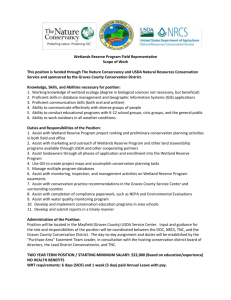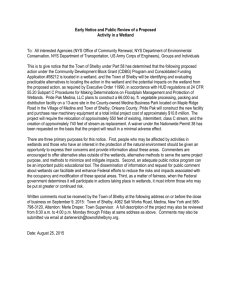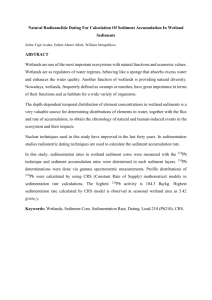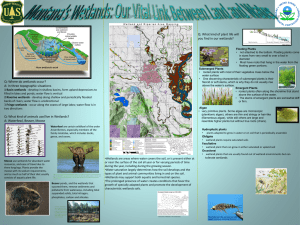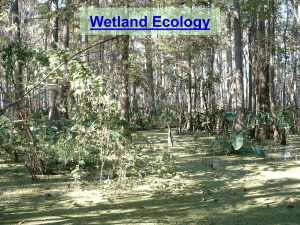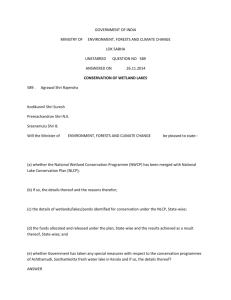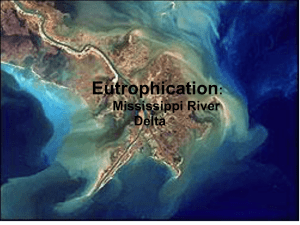Nonetloss21
advertisement
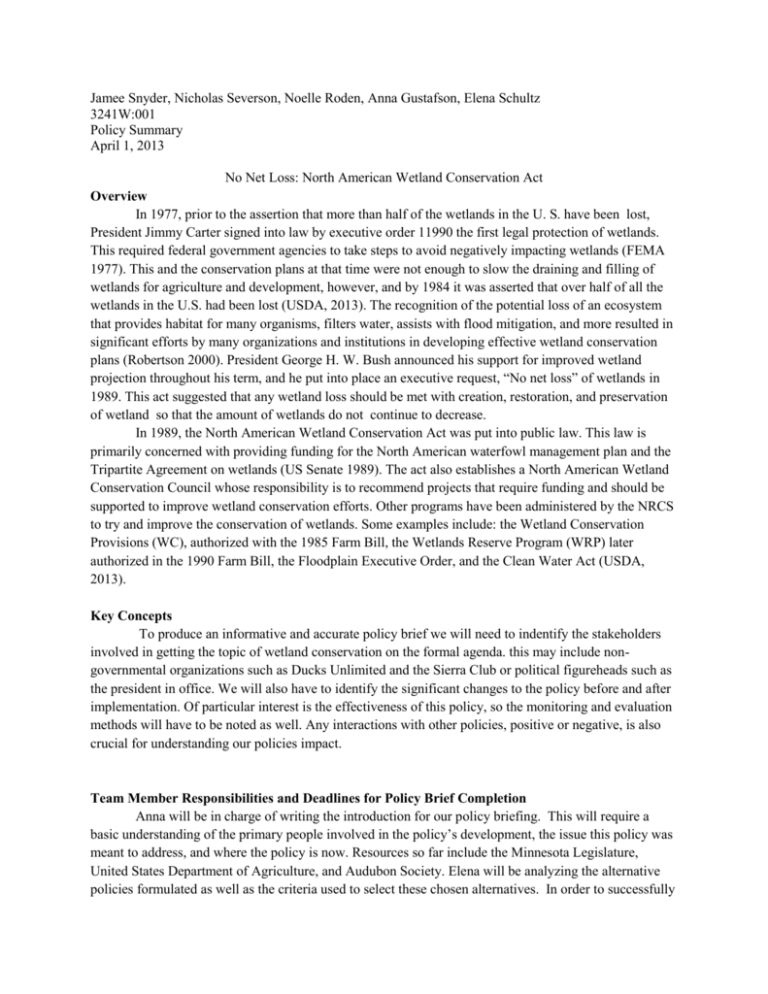
Jamee Snyder, Nicholas Severson, Noelle Roden, Anna Gustafson, Elena Schultz 3241W:001 Policy Summary April 1, 2013 No Net Loss: North American Wetland Conservation Act Overview In 1977, prior to the assertion that more than half of the wetlands in the U. S. have been lost, President Jimmy Carter signed into law by executive order 11990 the first legal protection of wetlands. This required federal government agencies to take steps to avoid negatively impacting wetlands (FEMA 1977). This and the conservation plans at that time were not enough to slow the draining and filling of wetlands for agriculture and development, however, and by 1984 it was asserted that over half of all the wetlands in the U.S. had been lost (USDA, 2013). The recognition of the potential loss of an ecosystem that provides habitat for many organisms, filters water, assists with flood mitigation, and more resulted in significant efforts by many organizations and institutions in developing effective wetland conservation plans (Robertson 2000). President George H. W. Bush announced his support for improved wetland projection throughout his term, and he put into place an executive request, “No net loss” of wetlands in 1989. This act suggested that any wetland loss should be met with creation, restoration, and preservation of wetland so that the amount of wetlands do not continue to decrease. In 1989, the North American Wetland Conservation Act was put into public law. This law is primarily concerned with providing funding for the North American waterfowl management plan and the Tripartite Agreement on wetlands (US Senate 1989). The act also establishes a North American Wetland Conservation Council whose responsibility is to recommend projects that require funding and should be supported to improve wetland conservation efforts. Other programs have been administered by the NRCS to try and improve the conservation of wetlands. Some examples include: the Wetland Conservation Provisions (WC), authorized with the 1985 Farm Bill, the Wetlands Reserve Program (WRP) later authorized in the 1990 Farm Bill, the Floodplain Executive Order, and the Clean Water Act (USDA, 2013). Key Concepts To produce an informative and accurate policy brief we will need to indentify the stakeholders involved in getting the topic of wetland conservation on the formal agenda. this may include nongovernmental organizations such as Ducks Unlimited and the Sierra Club or political figureheads such as the president in office. We will also have to identify the significant changes to the policy before and after implementation. Of particular interest is the effectiveness of this policy, so the monitoring and evaluation methods will have to be noted as well. Any interactions with other policies, positive or negative, is also crucial for understanding our policies impact. Team Member Responsibilities and Deadlines for Policy Brief Completion Anna will be in charge of writing the introduction for our policy briefing. This will require a basic understanding of the primary people involved in the policy’s development, the issue this policy was meant to address, and where the policy is now. Resources so far include the Minnesota Legislature, United States Department of Agriculture, and Audubon Society. Elena will be analyzing the alternative policies formulated as well as the criteria used to select these chosen alternatives. In order to successfully conduct this analysis, she will research the policy formulation process on a federal level in order to then develop a better understanding of the policy planning process in Minnesota regarding no net loss of wetlands. Potential sources include the Environmental Protection Agency, Fish and Wildlife Services, the Minnesota Board of Soil and Water Resources, and Natural Resources Conservation Services. Nick will be covering the history of the policy, including the players that got the topic on the formal agenda and the policies movement through legislation. Jamee will be responsible for describing the techniques used to move the policy through the policy process and the subsequent implementation procedures. Noelle will provide a description of the methods used for monitoring and evaluation of the policy and the results of such studies. While each person has been assigned a specific section, we will all discuss and comment on one anothers’ sections to ensure that everyone is involved in and understands each section. A draft of our policy brief will be completed by April 20, providing three days for proof-reading and editing. We plan to have our assigned sections for our final draft completed and compiled by May 1 to provide at least a week of review and improvement. Literature Cited Salzman, James, and J. B. Ruhl. 2005. “No Net-Loss” – Instrument Choice in Wetlands Protection (2005): n. pag. Scholarship.law.duke.edu. Duke Law School. Web. 26 Mar. 2013. <http://scholarship.law.duke.edu/cgi/viewcontent.cgi?article=2025&context=faculty_scholarship>. United States Department of Agriculture (USDA). 2013. Wetlands. Natural Resources Conservation Sciences. Web. 26 Mar. 2013. http://www.nrcs.usda.gov/wps/portal/nrcs/main/national/water/wetlands/ Dahl, Thomas E., and Gregory J. Allord. 1997. Technical Aspects ofWetlands History of Wetlands in the ConterminousUnited States. Water.usgs.gov. USGS. Web.26 Mar. 2013. <http://water.usgs.gov/nwsum/WSP2425/history.html>. United States Subcommittee on Environmental Protection (US Senate). 1989. The North American Wetland Conservation Act. Congressional publication Serial No. 101-133. Federal Emergency Management Agency (FEMA). 1977. Executive Order 11990, Protection of Wetlands. Web. 30 Mar. 2013. http://www.fema.gov/environmental-planning-and-historic-preservationprogram/executive-order-11990-protection-wetlands Robertson, M. M. 2000. No Net Loss: Wetland Restoration and the Incomplete Restoration of Nature. Antipode 32: 463-493. Bendor, Todd. 2009. A dynamic analysis of the wetland mitigation process and its effects on no net loss policy. Landscape and Urban Planning. 89: 17-27. LePage, B. A. 2011. Wetlands: A Multidisciplinary Perspective. Springer Science+Business Media. Chapter 1: 3-25. Board of Water and soil sciences (BWSR). 2009. Adopted permanent rules relating to wetland conservation. Chapter 8420: 1-134. The Library of Congress. 1989. Wetlands No Net Loss Act of 1989. Executive Comment Requested from Interior: H.R.1746. Web. 31 Mar 2013.
